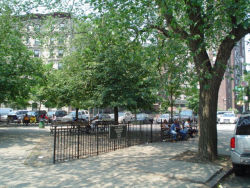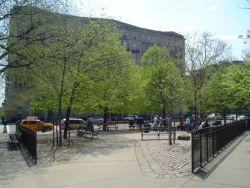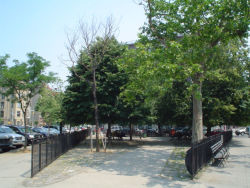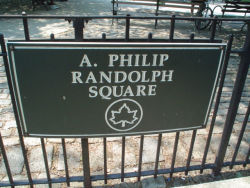A Philip Randolph Square
A. Philip Randolph Square
What was here before?
This section of Harlem was home to the Lenape prior to colonization by Dutch Settlers in the 1660s. St. Nicholas Avenue, lies west of this park, referred to as Harlem Lane during colonial times, connected Harlem Village to Spuyten Duyvil. A house was built by the Van Bramer family in the Dutch style on this site in the mid-1700s. This land remained in their family until at least 1891.
How did this site become a square?
The site was acquired by the City through condemnation in 1896 for the purpose of building a public park. It formerly contained one of the many brownstone milestone markers, c. 1769, that denoted the distance of various sites from City Hall.
The square named for Union general Judson Kilpatrick, opened in 1908 with a central walk flanked by grass plots and lined with trees and benches. In 1922 it was renamed for Admiral George B. Dewey, a naval hero in the Spanish-American War. Dewey Square also provided the inspiration for and title of a 1947 song by great jazz saxophonist Charlie Parker, who lived in the area at the time. The square was again renamed in 1964, this time for Asa Philip Randolph.
Who is this square named for?
The park is named for A. Philip Randolph (1889-1979), a labor unionist and civil rights activist.
Randolph was born in Crescent City, Florida and graduated from the Cookman Institute in Jacksonville before continuing his education at City College of New York in 1911. In 1917 Randolph and Chandler Owen founded The Messenger, a radical monthly publication that urged Black industrial workers to unionize. In 1925 the sleeping-car porters of the Pullman Railroad Company, drawn to Randolph's militant stance on labor and race issues, asked him to organize a union. After ten years of negotiations, the managers of the Pullman Company met Randolph's demands. They granted $2 million in wage increases and officially recognized the Brotherhood of Sleeping Car Porters, the first black union in the country.
Randolph successfully pressured President Roosevelt (1882-1945) to issue the historic Executive Order 8802 on July 31, 1941, which banned discrimination in the defense industry and led to the establishment of the Fair Employment Practice Commission. In 1955, the veteran labor leader became the first Black vice-president of the American Federation of Labor and Congress of Industrial Organizations (AFL-CIO). On August 28, 1963, Randolph and Bayard Rustin directed the March on Washington for Jobs and Freedom, during which civil rights leader Dr. Martin Luther King Jr. (1929-1968) delivered his famous "I Have a Dream" speech. In 1965, they founded the A. Philip Randolph Institute to strengthen ties between labor, political and civil rights organizations. He retired from public life and died in 1979. His ashes are interred at the A. Philip Randolph Institute.
Check out your park's Vital Signs
Clean & Safe
Green & Resilient
Empowered & Engaged Users
Share your feedback or learn more about how this park is part of a
Vital Park System




